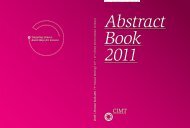Abstract Book 2010 - CIMT Annual Meeting
Abstract Book 2010 - CIMT Annual Meeting
Abstract Book 2010 - CIMT Annual Meeting
Create successful ePaper yourself
Turn your PDF publications into a flip-book with our unique Google optimized e-Paper software.
071 Kleemann | New targets & new leads<br />
Identification of T-cell defined varicella-zoster virus proteins<br />
Patrick Kleemann 1 , Stefan Tenzer 2 , Eva Distler 1 , Eva Wagner 1 Ralf G. Meyer 1 , Sebastian<br />
Klobuch 1 , Simone Thomas 1 , Steffi Aue 3 , Bodo Plachter 3 , Wolfgang Herr 1<br />
1 Dept. of Medicine III, Hematology & Oncology, University Medical Center, Mainz, Germany<br />
2 Institute for Immunology, University Medical Center, Mainz, Germany<br />
3 Institute for Virology, University Medical Center, Mainz, Germany<br />
116<br />
Reactivated infection with varicella-zoster virus<br />
(VZV) causes herpes zoster. In immunodeficient<br />
cancer patients (e.g. after hematopoietic stem cell<br />
transplantation) dissemination of the virus can lead<br />
to life-threatening disease. Although an efficient<br />
live attenuated VZV vaccine for zoster prophylaxis<br />
exists, it is not approved in immunocompromised<br />
patients due to safety reasons. Knowledge of immunogeneic<br />
VZV proteins would allow designing a noninfectious<br />
nonhazardous subunit vaccine suitable<br />
for patients with immunodeficiencies. The objective<br />
of this study is to identify T-cell defined virus<br />
proteins of a VZV-infected Vero cell extract that we<br />
have recently described as a reliable antigen format<br />
for IFN-g ELISPOT assays (Distler et al. Biol. Blood<br />
Marrow Transplant. 2008, 14:1417-24). We first<br />
separated the VZV-infected/-uninfected Vero cell<br />
extracts by ultracentrifugation and reverse-phase<br />
HPLC. The collected fractions were screened for<br />
reactivity with peripheral blood mononuclear cells<br />
(PBMC) of VZV-seropositive healthy individuals<br />
by IFN-g ELISPOT assay. Using this strategy, we<br />
successfully identified bioactive HPLC fractions<br />
that contained immunogeneic VZV material. The<br />
immune reactivity was mediated by CD4+ memory<br />
T cells of VZV-seropositive healthy individuals as<br />
demonstrated by experiments with T-cell subpopulations.<br />
We next analyzed the bioactive HPLC<br />
fractions with MALDI and ESI mass spectrometry<br />
techniques and identified three (glycoprotein<br />
E; glycoprotein B and immediate early protein 62)<br />
different VZV derived proteins. In subsequent experiments<br />
we expressed these VZV-encoded proteins<br />
in dendritic cells (DCs) by in vitro transcribed<br />
RNA and screened transfected DCs with autologous<br />
T cells. Based on these experiments we established<br />
a protocol to perform these studies with PBMC of<br />
healthy donors and patients after hematopoietic<br />
stem cell transplantation. The work will hopefully<br />
lead to protein candidates of VZV to be included<br />
in a subunit vaccine, which can be safely used for<br />
zoster prophylaxis in immunocompromised cancer<br />
patients.



